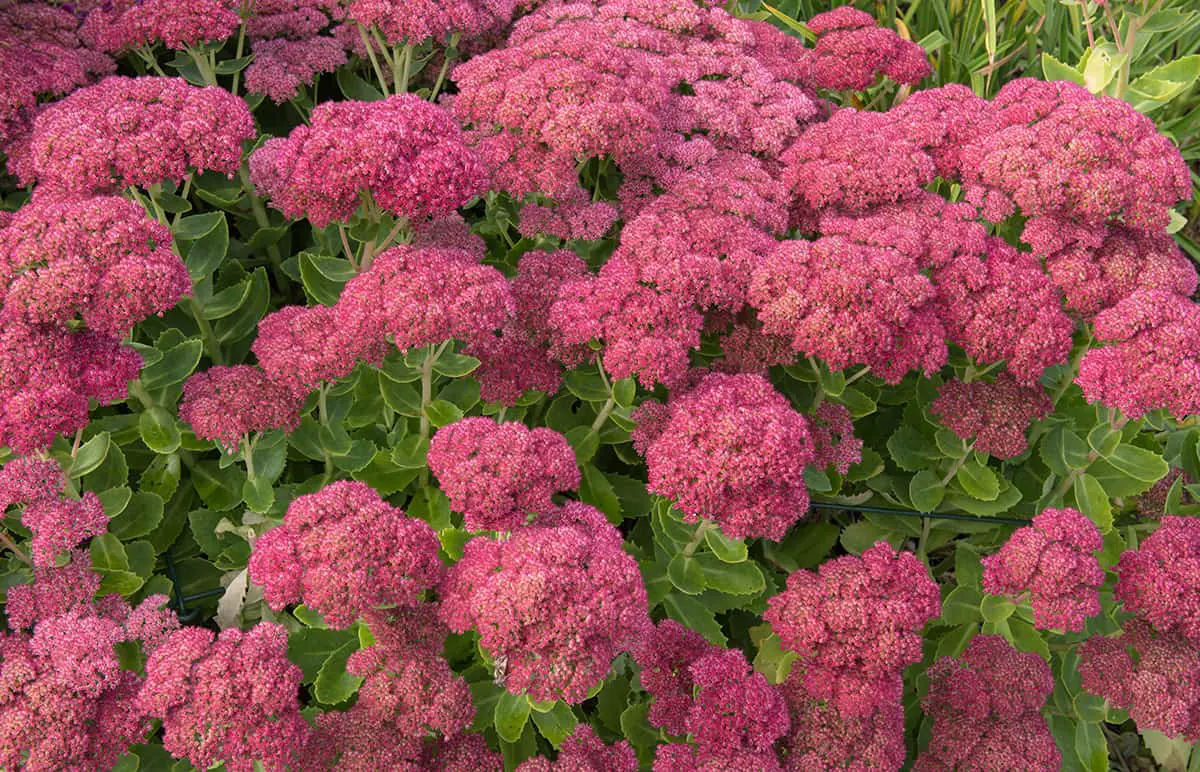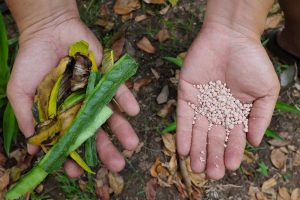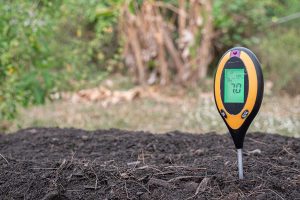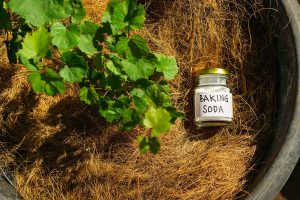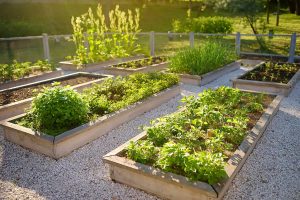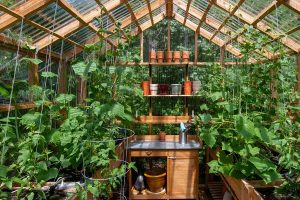In a small, neglected corner of the garden, where the soil is more dust than dirt, a cluster of lavender plants blooms vibrantly, defying the odds. This resilience is not unique to lavender; many plants thrive in poor soil, turning barren patches into lush landscapes. Such plants are nature’s testament to the power of adaptation, offering a beacon of hope for gardeners grappling with less-than-ideal earth.
This article explores the world of these hardy species, providing insights on how to transform challenging spaces into thriving green havens.
Table of Contents
- What Is Low-Quality Soil?
- Benefits of Planting in Poor Soil
- African Daisy (Osteospermum)
- Autumn Joy Sedum
- Black-Eyed Susan (Rudbeckia Hirta)
- Bougainvillea
- Butterfly Weed (Asclepias Tuberosa)
- Chamomile (Matricaria Recutita)
- Cockscomb (Celosia)
- Cosmos
- Crotalaria
- Cup Plant
- Foxtail Lilies (Eremurus)
- Jamaican Bluespike
- New York Ironweed (Vernonia Noveboracensis)
- Perennial Sunflower (Helianthus)
- Periwinkle (Vinca Minor)
- Purple Coneflower (Echinacea Purpurea)
- Rain Lily
- Rose Of Sharon (Hibiscus Syriacus)
- Shankapushpi
- Tickseed (Coreopsis)
- Wedelia
- Wild Bee Balm (Monarda Fistulosa)
- Yarrow (Achillea)
What Is Low-Quality Soil?
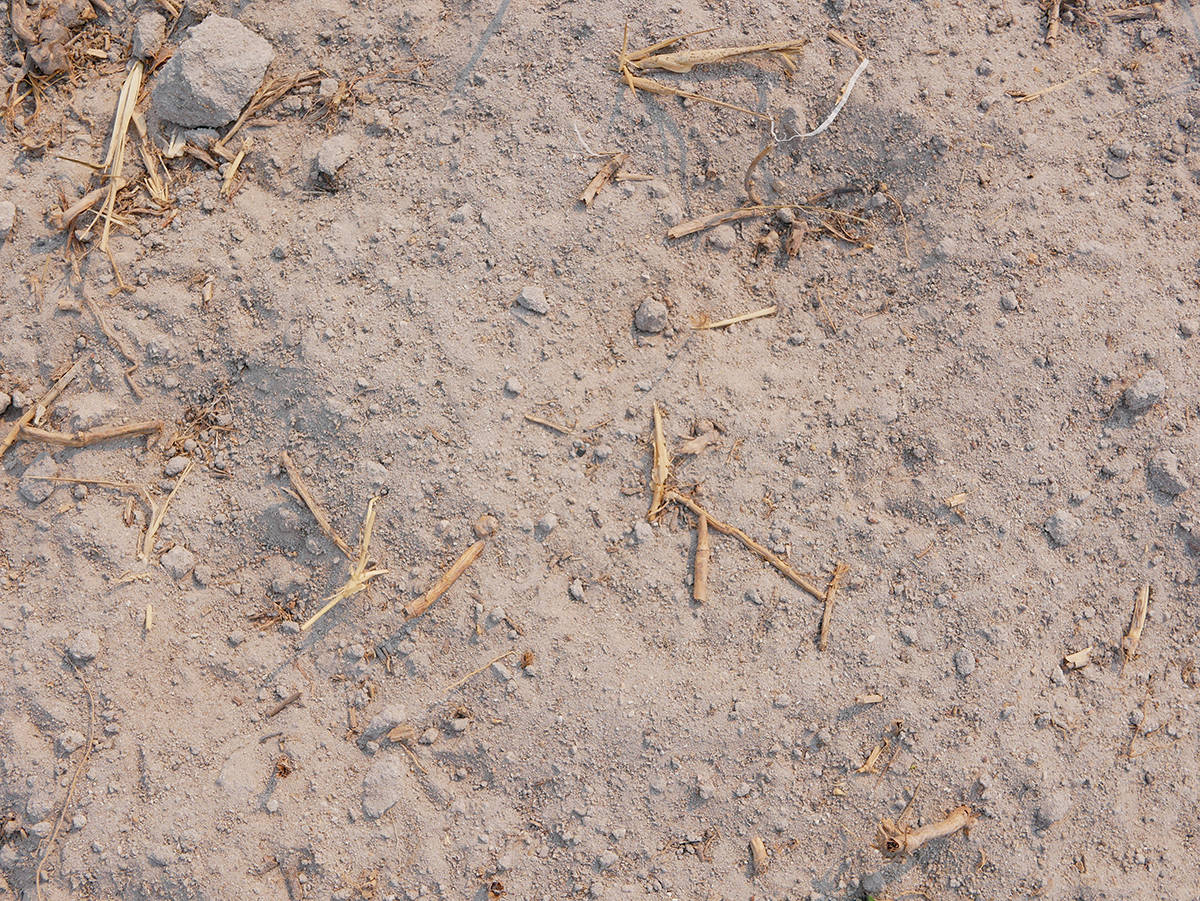
Low-quality soil often lacks the key elements that plants need to grow well. Your garden’s success depends on the soil’s quality. This type of soil usually has poor structure, which can hinder water infiltration and root growth.
Low-quality soil is defined by several key characteristics that can negatively impact plant growth. Firstly, it has a low nutrient content, meaning essential nutrients such as nitrogen, phosphorus, and potassium are present in minimal amounts.
Secondly, such soil often suffers from poor drainage, leading to water pooling on the surface because the soil cannot absorb moisture effectively. Additionally, compaction is a common issue, where the soil particles are densely packed together, making it difficult for plant roots to penetrate and access the nutrients they need to thrive.
To identify low-quality soil in your garden or outdoor space, there are a few signs to look for. A hard surface is a clear indicator, as it suggests compaction and poor structure. Sparse plant growth can also signal soil that lacks the necessary nutrients or has other issues such as drainage problems.
Moreover, if you notice waterlogging after rain, where water remains standing rather than being absorbed, it’s a strong indication that the soil has poor drainage and may be of low quality.
Benefits of Planting in Poor Soil
Plants that thrive in poor soil can bring unexpected advantages. Your garden may flourish with low-maintenance species. These plants typically need less fertilizer and water. This can save both resources and time.
Certain varieties, adapted to struggle, often possess strong defense mechanisms. They resist pests and diseases well. This reduces the need for chemicals, promoting a healthier environment. Your garden becomes a resilient ecosystem.
Landscaping can extend to challenging areas with these hardy plants. Hillsides and rocky terrain transform into beautiful spaces. They provide stabilization, reducing erosion and improving soil over time.
In urban settings, poor soils are common. Yet, these adaptable plants enable green spaces. They add biodiversity and curtail the urban heat effect. You contribute to urban wildlife habitats and enjoy a greener community.
African Daisy (Osteospermum)
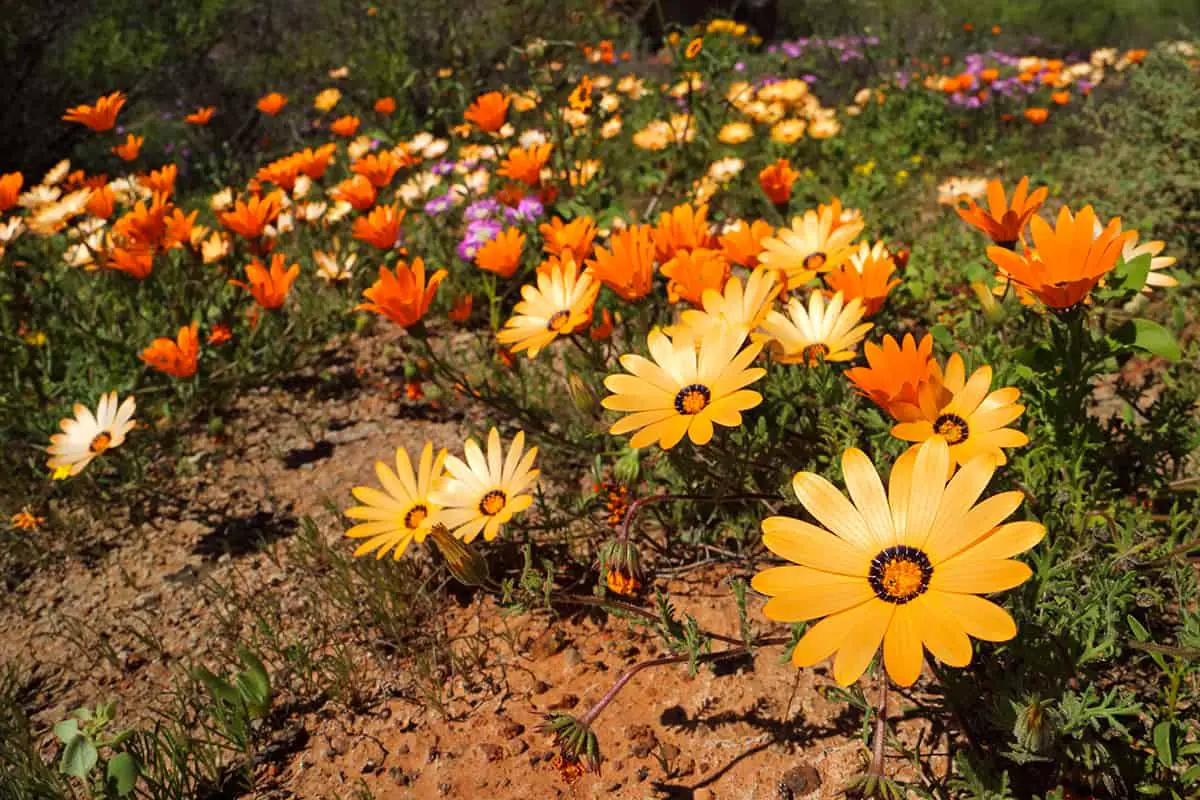
African Daisy, known scientifically as Osteospermum, is a resilient plant. It performs well in less fertile soils. You will find its vibrant flowers a standout in any garden setting. These daisies hail from South Africa, but they adapt well to various conditions.
The ideal growing conditions for these plants include a preference for full sunlight, indicating that they thrive best when exposed to ample sunshine throughout the day. Moderate watering is sufficient, ensuring that the plants receive enough moisture without being overwatered. While these plants can tolerate poor soil conditions, it is crucial to ensure that the soil has good drainage to prevent waterlogging and promote healthy root development.
For optimal care, it is recommended to space the plants appropriately during planting to prevent overcrowding, which can lead to various growth and health issues. Regular maintenance should include deadheading, the process of removing spent blooms, which encourages the plant to produce more flowers.
The flowers of the African Daisy are particularly notable for their vibrant blend of colors and distinctive center disk. These blooms have a unique characteristic of closing at night and on cloudy days. They are available in a variety of shades, including pink, purple, blue, or white, adding a splash of color and diversity to any garden setting.
Remember to check plants regularly. Look for signs of root rot in cool, wet conditions. Also, African Daisy benefits from consistent deadheading. This practice will help prolong the flowering period.
Autumn Joy Sedum
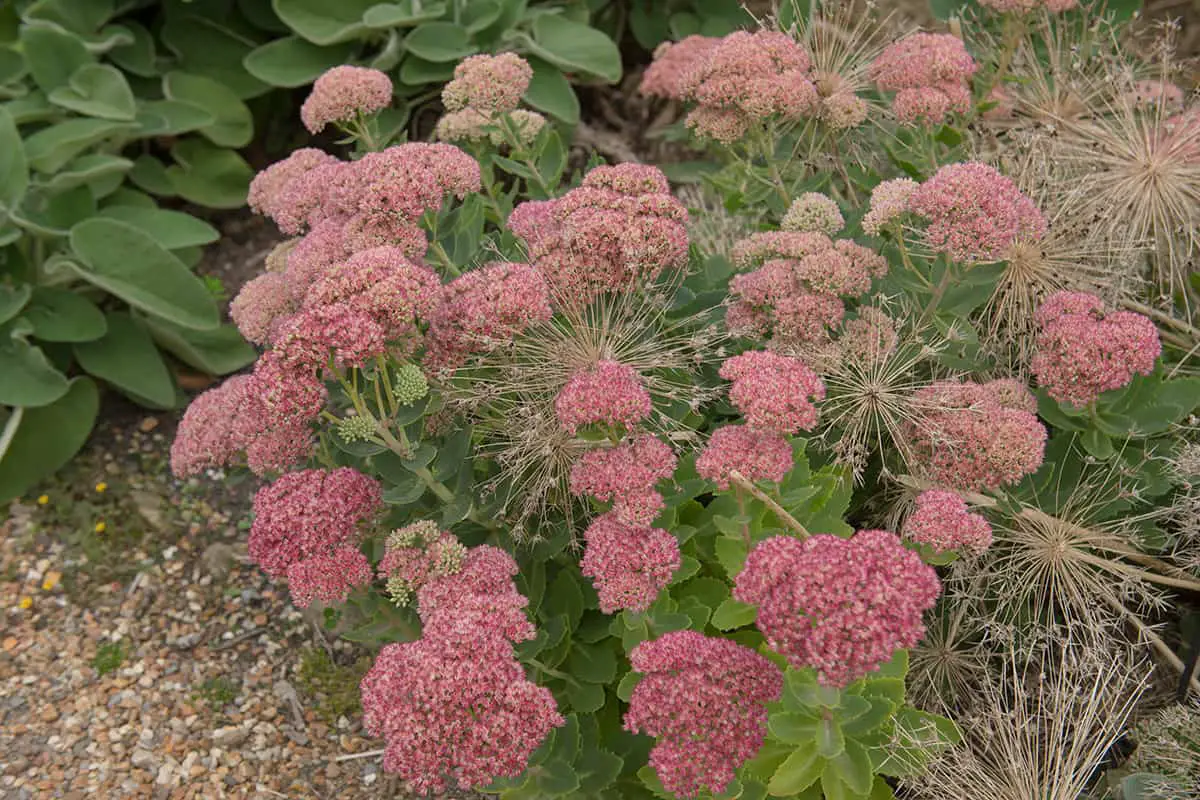
Autumn Joy Sedum is a robust plant for your garden. It thrives in poor, dry soils where other plants struggle.
The plant prefers full sun but can also tolerate partial shade, making it versatile for different garden spots. For soil conditions, well-drained or gravelly types are considered ideal, ensuring the plant’s roots do not sit in waterlogged soil.
The plant typically grows to a height of 1 to 2 feet and can spread up to 2 feet wide, creating a substantial presence in the garden. The bloom time is particularly noteworthy, with flowers maturing from bright pink to a striking copper-red, offering a dynamic range of colors throughout its flowering period.
When it comes to care tips, minimal watering is necessary, which makes this plant a great option for low-maintenance gardens. It is advised to avoid enriching the soil too much, as the plant thrives in less fertile conditions. For winter interest, leaving the dried flower heads on the plant can add texture and visual appeal to the garden during the colder months.
Black-Eyed Susan (Rudbeckia Hirta)
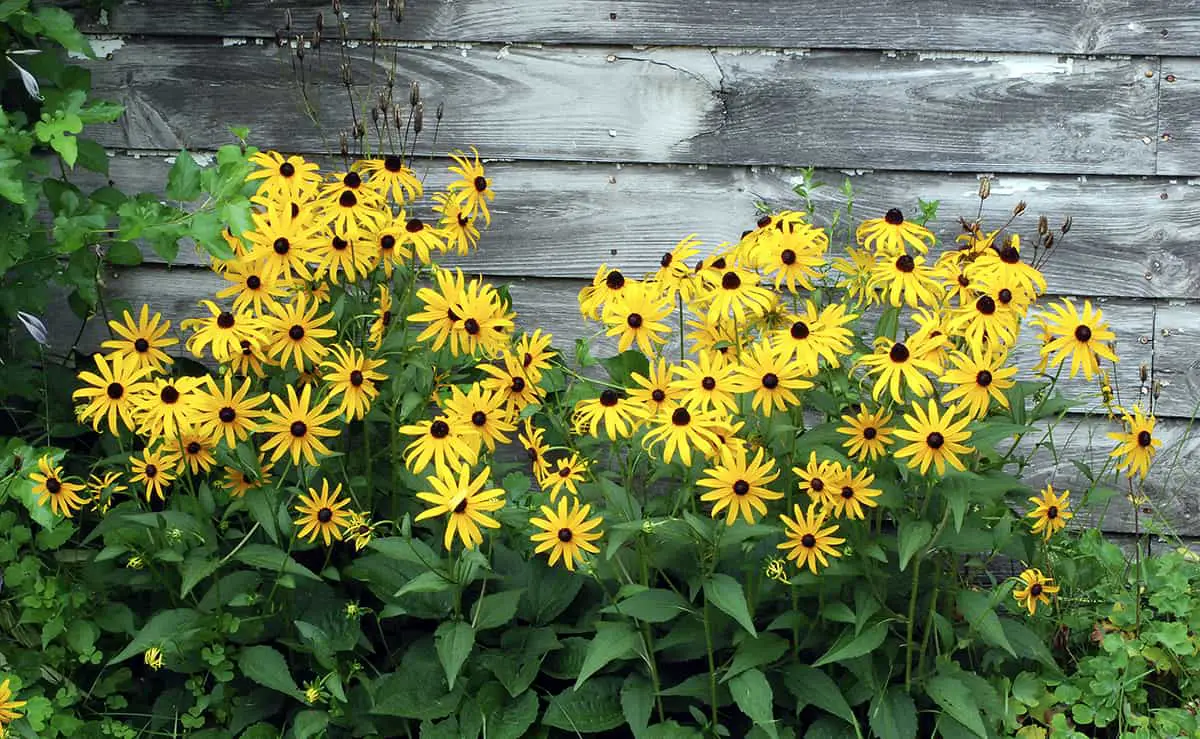
When you’re working with poor soil in your garden, the Black-Eyed Susan stands out as a resilient choice. This plant boasts bright yellow petals surrounding a dark brown center.
The Black-Eyed Susan stands tall at 24 to 36 inches and is adaptable to various soil types, including clay, loam, or sandy soil. It flourishes under full sun to partial shade, making it a versatile addition to any garden. This plant thrives in conditions of moderate fertility and is not particularly demanding regarding soil quality. It grows best in well-drained soil but is also capable of withstanding occasional droughts.
It is important to water the plant regularly during its establishment phase to ensure healthy growth. It is advisable to avoid excess nitrogen in fertilizing, as it can adversely affect the plant’s bloom production. Additionally, when planting, ensure to provide adequate spacing between plants to promote good air circulation, which is essential for preventing disease and encouraging robust growth.
Bougainvillea
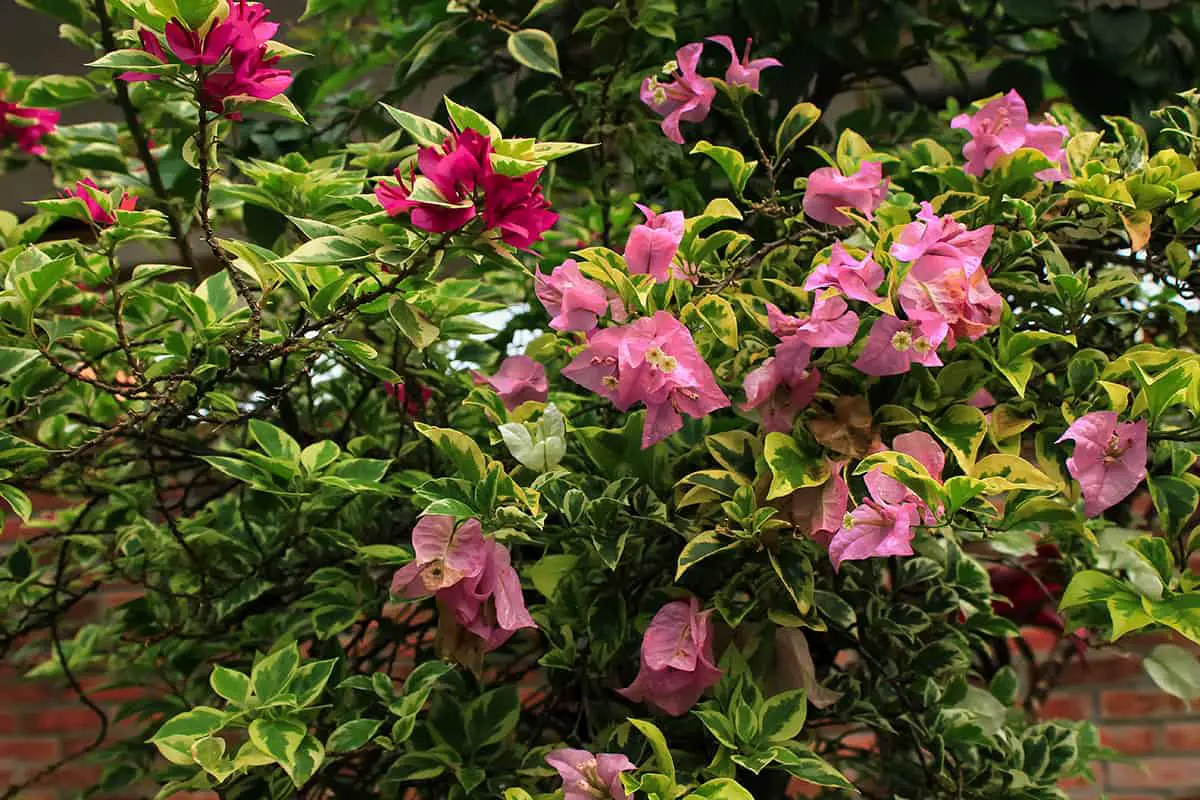
Bougainvillea plants are exceptional for their tolerance to poor soil. Your Bougainvillea can thrive even in conditions that are less than ideal. You just need to provide plenty of sun and ensure good drainage.
Drainage is a critical aspect of soil requirements for healthy plant growth. Well-drained conditions are essential for optimal development. A recommended soil mix might include components such as rotted pine bark, peat moss, and coarse perlite. The soil’s acidity is also vital; targeting an acidic pH range of 5.5 to 6.0 is advisable, as alkaline soils should be avoided.
Regarding plant care, full sun exposure is necessary for the plant to thrive and achieve optimal growth. Bougainvillea is known for its drought tolerance once it has been properly established. Regular pruning is essential for promoting growth and maintaining the plant’s shape. Fertilization with a balanced fertilizer supports healthy blooming and enhances the plant’s overall vitality.
For those considering container planting, bougainvillea can successfully grow in pots, provided they are filled with the right soil mix. In landscaping, bougainvillea is an excellent choice for adding vibrant color along fences or trellises, bringing life and beauty to garden spaces. When handling the plant, it’s important to be gentle with its roots, as they are quite fragile and require careful treatment to avoid damage.
Butterfly Weed (Asclepias Tuberosa)
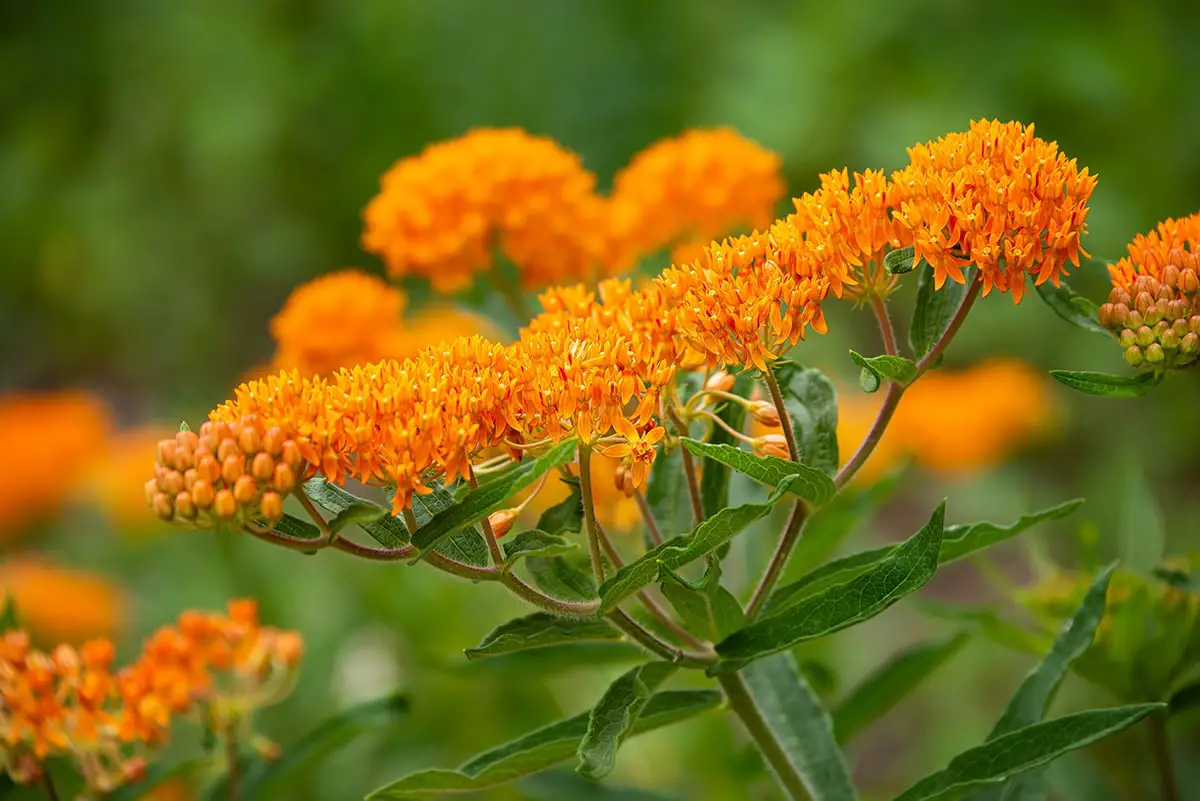
Butterfly weed is vibrant and durable. With its showy flowers, it adds splashes of color to difficult garden spots. You’ll find that it requires minimal care.
The Butterfly Weed is a vibrant plant that grows up to two feet tall and blooms from July to September. It showcases a beautiful array of colors, including orange, red, and yellow hues. This plant is a magnet for pollinators, bringing your garden to life with the buzz of activity. It is particularly irresistible to monarchs and hummingbirds, making it a crucial addition to any wildlife-friendly yard.
Interestingly, the Butterfly Weed does not require rich soil to thrive. Its drought tolerance is attributed to a deep taproot, allowing it to stand out beautifully even in dry conditions.
When it comes to care, the Butterfly Weed prefers full sun to partial shade and has a low water requirement.
For those considering planting Butterfly Weed, it is important to avoid wet, heavy soils to allow for proper growth. Providing enough space for the plant to establish its taproot is crucial. One should also be prepared for slow initial growth and exercise patience as the plant takes time to fully mature.
Chamomile (Matricaria Recutita)

Chamomile is a robust herb that prefers full sun but doesn’t require rich soil or fertilizers. Wisely chosen for its simplicity and aromatic flowers, Matricaria recutita is a great addition to any garden.
For optimal growth, it’s important to provide full sun to your plants. They thrive in well-drained soil that is not necessarily of high quality, making chamomile an accessible plant for various gardening conditions. To ensure healthy growth, maintain moisture in the upper layer of the soil and keep an eye out for aphids, although chamomile generally has few pest concerns.
Planting chamomile in your garden offers several benefits. It is not only used in teas and as a garnish, adding a functional aspect to your garden, but its white flowers with yellow centers also enhance the aesthetic appeal of your garden space. Furthermore, chamomile is known for its ability to reseed, ensuring its continuous presence in your garden.
When caring for chamomile, your routine should include planting the tiny seeds on the surface of the soil without burying them deep. Regular watering is essential to keep the soil moist, which supports the plant’s growth. The flowers are ready for harvest when they are fully open, providing you with the perfect time to gather them for use.
Cockscomb (Celosia)
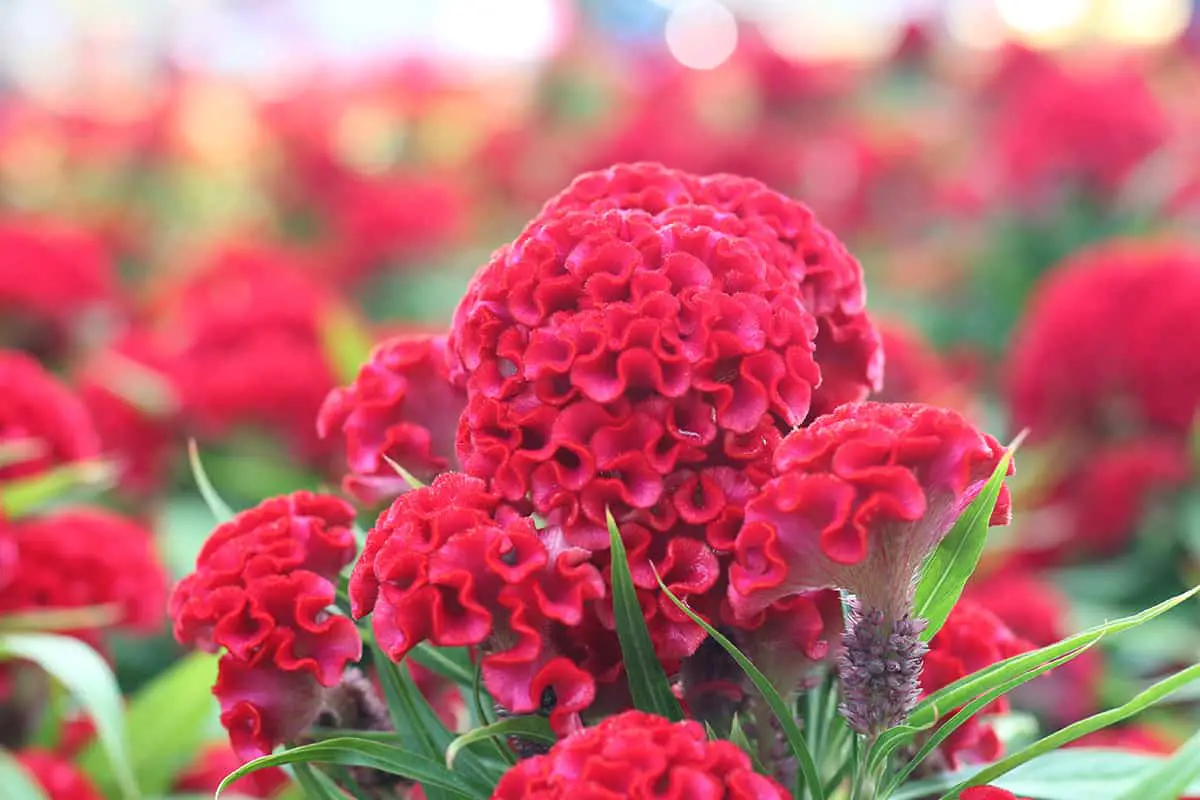
You will find this annual plant is resilient and adds vibrant color to your garden. The attractive flowers of Cockscomb come in shades of yellow, red, orange, and more.
Growth requirements for Cockscomb are minimal, making it suitable for challenging environments. It prefers full sun but will tolerate partial shade. Celosia thrives in well-drained soil, yet it can grow in less fertile substrates. Water the plant well initially; then it becomes quite drought-resistant.
To plant Cockscomb, space them about 10 to 12 inches apart. This spacing ensures ample airflow and reduces the risk of disease. For optimal results, enrich your garden with compost or a general-purpose fertilizer to boost nutrient availability.
In terms of maintenance, Cockscomb is low-effort. It resists disease and isn’t a common target for pests. Deadhead spent blooms to encourage continued flowering. Your garden will display a long season of blooms thanks to this hardy plant’s vigor.
Cosmos

Cosmos are an excellent choice for your garden if you’re dealing with poor soil. These flowers, known for their vibrant petals, thrive in environments where other plants may struggle. Plant cosmos seeds when the soil temperature is at least 65°F to ensure proper germination. They grow best in full sun, so pick a spot where they can soak in plenty of direct light.
When preparing the soil for the cosmos, it’s best to avoid rich soils as these plants thrive in less fertile conditions. A simple raking through the bed to loosen the soil is sufficient. Ensure to remove any weeds or large debris before planting to give your cosmos the best start.
For planting, sow the seeds directly into the ground, spacing them about 18 inches apart. It’s important not to plant the seeds too deeply; a light covering of soil over them is ideal. Keep the soil moist for the first 5 to 10 days to encourage germination.
You can expect to see sprouts within a week, with flowers appearing between eight and twelve weeks. Cosmos are resilient plants that can tolerate low-water conditions and require minimal maintenance for a thriving display. To encourage ongoing blooms, deadheading and shearing every 30 days can be beneficial. With colors ranging from white to deep cranberry, cosmos are a fantastic way to enhance your garden’s palette, even in less-than-ideal soil conditions.
For successful growth, water the plants modestly, as overwatering can impede their development. Thin the seedlings as they grow to prevent overcrowding, ensuring each plant has enough space to reach its full potential.
Crotalaria
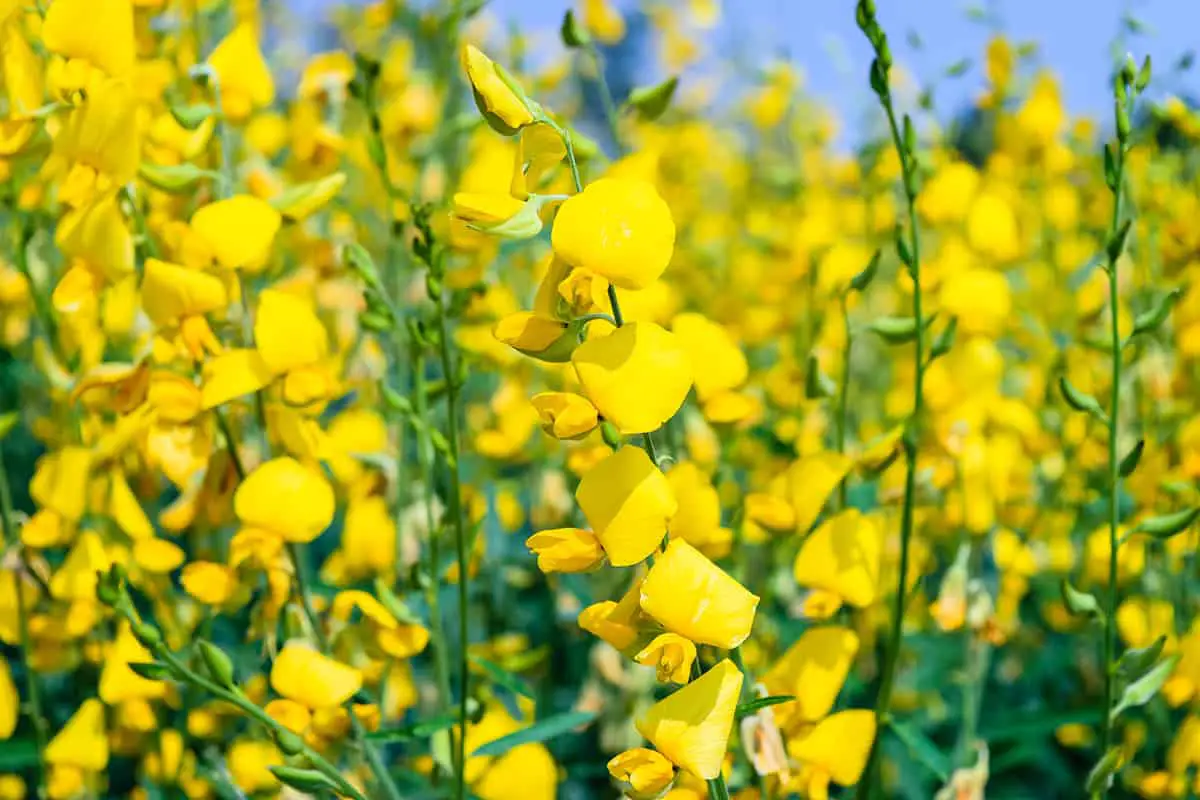
Crotalaria, also known as rattlebox, is notable for its resilience in poor soils. You may encounter over 600 species within this genus. Many are native to Africa, but there are species native to the United States as well.
Crotalaria plants are part of the legume family, recognized for their nitrogen-fixing ability. This unique trait allows them to deposit nitrogen back into the soil, which can improve soil conditions. You’ll find them useful, especially if you’re looking to revitalize your garden.
Crotalaria thrives in a wide range of environments, from the damp grasslands to the sandy soils found in Florida. If you’re considering adding Crotalaria to your garden, it’s important to manage these plants with care. While they offer benefits, some species of Crotalaria can become invasive if not properly controlled.
Despite the advantages that Crotalaria plants bring, such as enhancing soil fertility, it’s crucial to exercise caution. Many species within the Crotalaria genus possess poisonous qualities.
Cup Plant
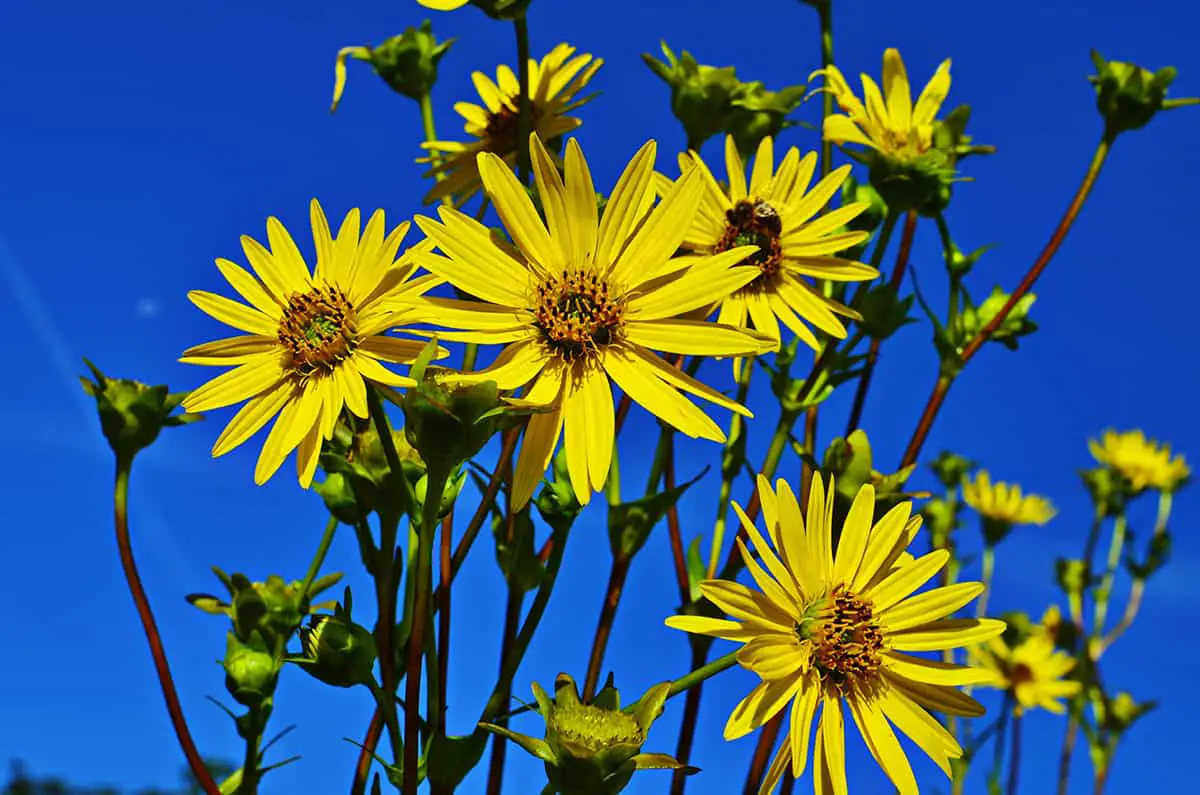
A member of the Asteraceae family, The Cup plant is not only a hardy choice for your garden but also brings ecological benefits.
The Cup plant, with its height ranging from 4 to 8 feet and width from 1 to 3 feet, is a native plant that commands attention in any space it occupies. Its name derives from the leaves’ unique cup shape, which can hold water, providing a hydration source for birds. This feature, coupled with its bright flowers, makes the Cup plant not only visually striking but also a magnet for pollinators. It plays a crucial role in providing wildlife cover and serves as a food source, making it an excellent choice for anyone looking to support local ecosystems.
When it comes to growth, the Cup plant is not fussy about soil quality and can thrive in poor soil conditions. It prefers full sun to partial shade and has low water requirements, making it a low-maintenance addition to gardens. You can start growing this plant from seed or plugs, offering flexibility in your gardening endeavors. It is worth noting that flowering usually occurs in the second or third year, allowing gardeners to plan and develop other garden areas in the meantime.
However, it’s important to consider that some may find the Cup plant too weedy for their taste. Additionally, it offers a habitat for Gall Wasps. While this may be seen as a downside, it also underscores the plant’s role in supporting a diverse range of wildlife, highlighting its value in ecological gardening practices.
Foxtail Lilies (Eremurus)

Foxtail Lilies bring charm to areas with less fertile soils. These perennials thrive in well-drained conditions. You’ll find them ideal for rock gardens and borders. They need sun and a shield from strong winds.
These plants have a striking appearance. Their long, slender spikes boast colorful flowers. You often see them in yellow, orange, or pink. They bloom in late spring or early summer.
You should plant Foxtail Lilies in loose, sandy loam. Avoid heavy, wet soils that can rot the roots. When planting, space them about 12 inches apart.
Remember, Foxtail Lilies are not drought-tolerant. Maintain consistent moisture for them to flourish. It’s best to divide them every 3-4 years to keep them healthy.
Jamaican Bluespike

The Blue porterweed, more commonly known as Blue porterweed, thrives in conditions that favor full sunlight, showcasing its preference for bright environments. It is a hardy plant that tolerates poor soil quality, making it adaptable to various gardening conditions. Once established, it requires moderate watering and exhibits drought tolerance, further attesting to its resilience. This plant is ideally suited for borders or groundcover, thanks to its sprawling habit and attractive foliage.
Owing to its versatile nature, the Blue porterweed can also be successfully grown in containers. This adaptability makes it a suitable choice for areas with limited space, allowing gardeners to manage its growth effectively. The plant’s resilience enables it to flourish in challenging conditions that might hinder the growth of other plants.
In addition to its hardiness, the Blue porterweed offers several benefits. It attracts a wide range of pollinators, contributing to the health of your garden’s ecosystem. Moreover, it boasts year-round blooms, providing continuous color and interest in the garden.
New York Ironweed (Vernonia Noveboracensis)
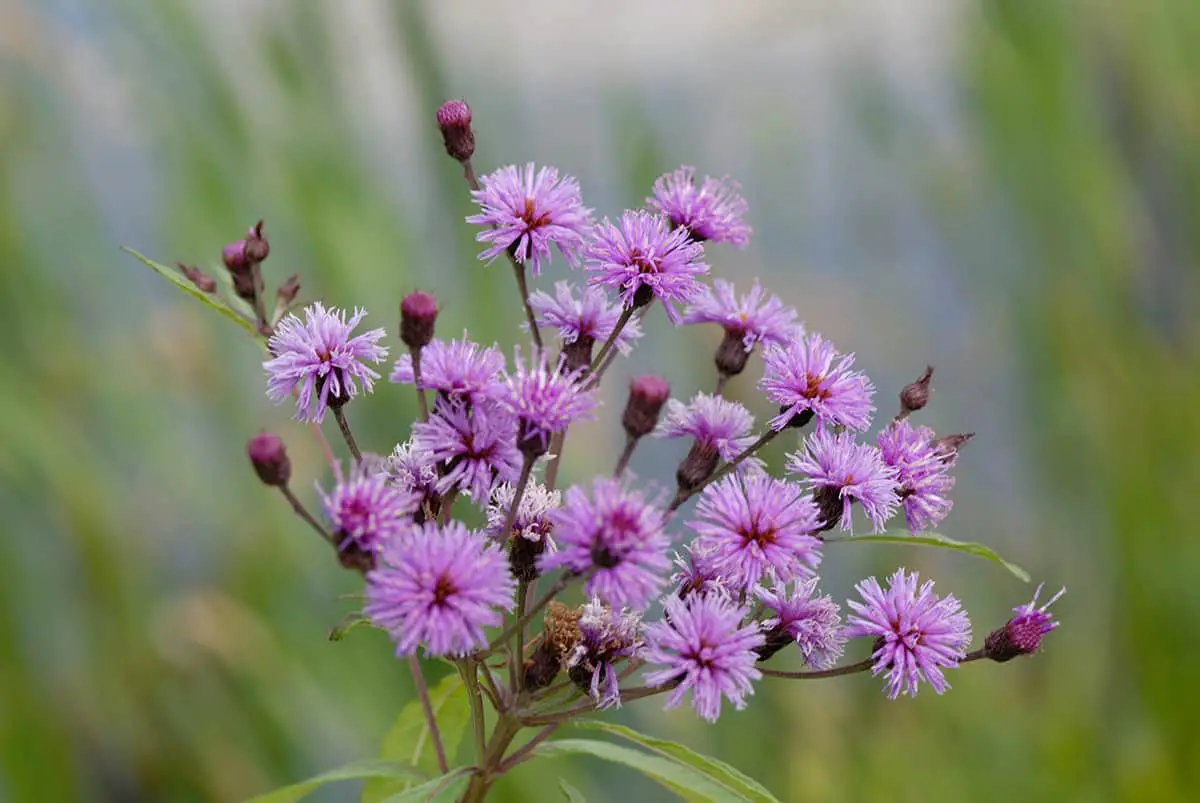
New York Ironweed thrives in less fertile soil. This hardy plant features vivid purple flowers and can reach up to 8 feet tall. It’s a perennial, blooming from August to September.
You’ll notice its clumping growth habit forms dense stands. Ideal for rain gardens or the back of a border, it adds height and color. It supports local wildlife too.
When planting New York Ironweed, it is essential to place it in an area that receives full sun. This plant thrives in moist to average soil conditions. As for maintenance, it is relatively low; cutting back the plant in spring can result in a shorter stature, simplifying its care.
Perennial Sunflower (Helianthus)
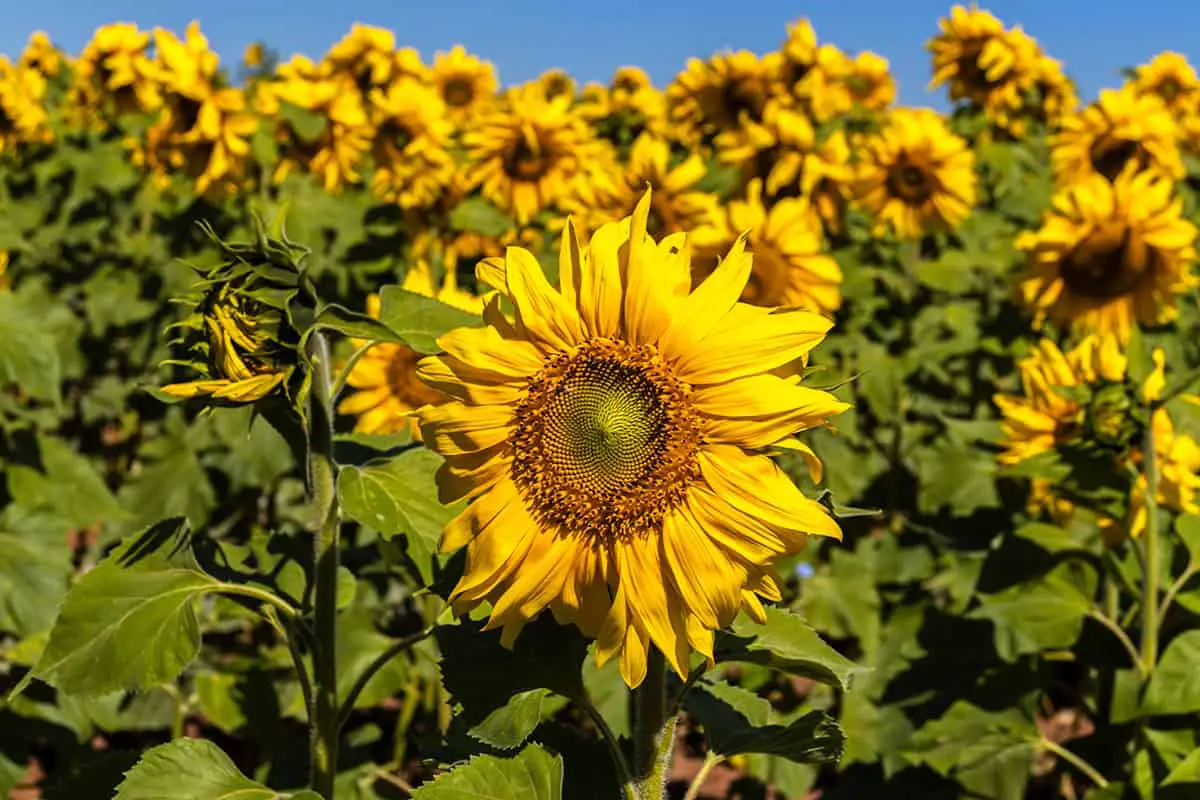
Perennial sunflower, or Helianthus, is a robust plant belonging to the Helianthus species. These are known for their durability. They have deep roots that help them access nutrients in subpar soil. These plants prefer full sun but can manage with less.
Some varieties like ‘Suncatcher’ and ‘Lemon Queen’ offer smaller growth or unique colors. You’ll find these varieties are well-suited to home gardens and can thrive in less-than-ideal soil.
While resilient, perennial sunflowers do benefit from occasional care. Minimal fertilization and rare pruning often suffice. They are not typically bothered by pests.
Your garden will gain aesthetic appeal with Helianthus. Besides, they attract beneficial pollinators, enhancing your garden’s ecosystem. In regions with poor soil, perennial sunflowers shine as a dependable choice.
Periwinkle (Vinca Minor)
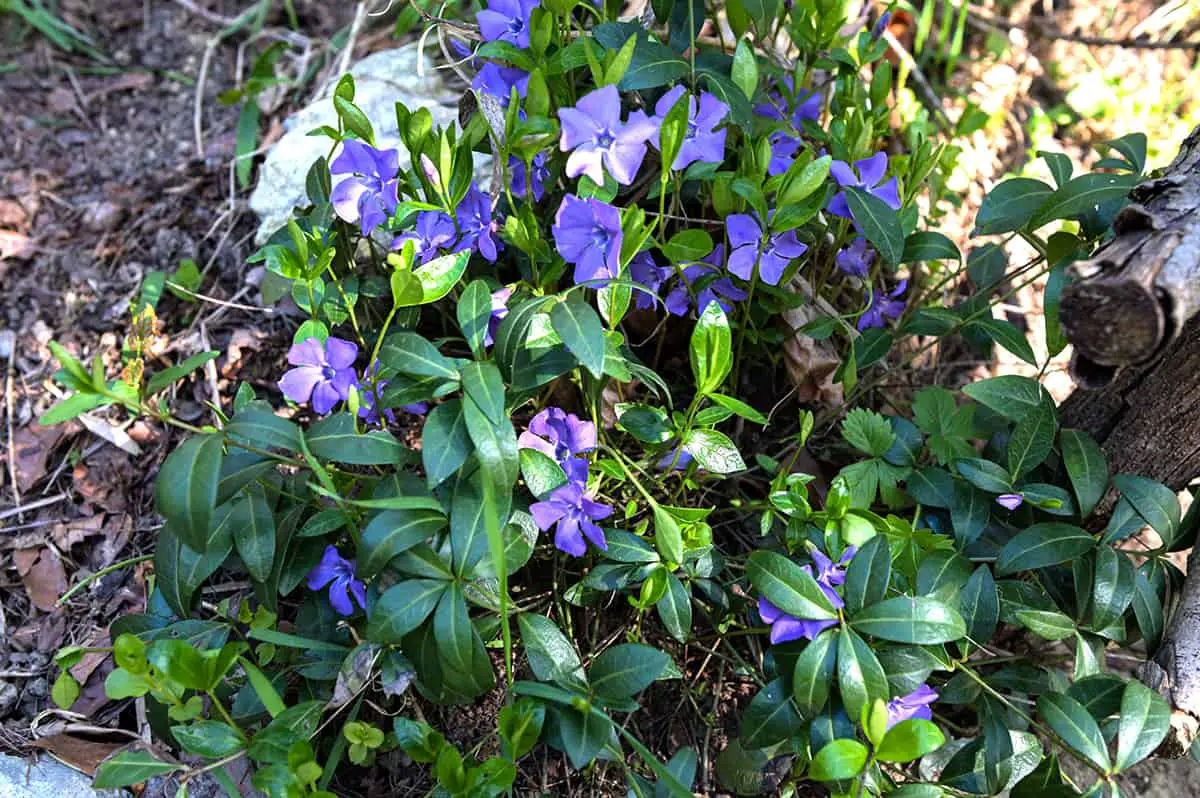
Periwinkle, or Vinca minor, thrives in less-than-ideal soil conditions. This plant exhibits a strong tolerance for various climate conditions, notably its ability to withstand high heat, making it suitable for warmer climates. It shows a preference for partial to full shade, indicating that it thrives in areas where direct sunlight is moderated.
In terms of physical characteristics, the plant reaches a modest height of approximately 6 inches. Its spread can extend from 0.5 to 1.5 feet wide, making it an excellent choice for ground cover or filler in garden beds.
Vinca minor, a perennial evergreen, possesses leathery foliage and delicate flowers. During spring and early summer, its blue-lavender flowers emerge. Occasional blooms may appear throughout the year.
When planting Vinca minor, space individuals 1-2 feet apart to allow for spreading. This plant sends out trailing shoots that root to form new plants, contributing to its invasive potential. Regular pruning helps manage its growth.
Adding humus to the soil is beneficial for enhancing moisture retention. Keep in mind that it can be too invasive, requiring frequent maintenance. Vinca minor is ideal for covering slopes or hillsides. While it can tolerate moist soil, ensure proper drainage to prevent stem-rot disease. You should water it regularly for best results.
Purple Coneflower (Echinacea Purpurea)
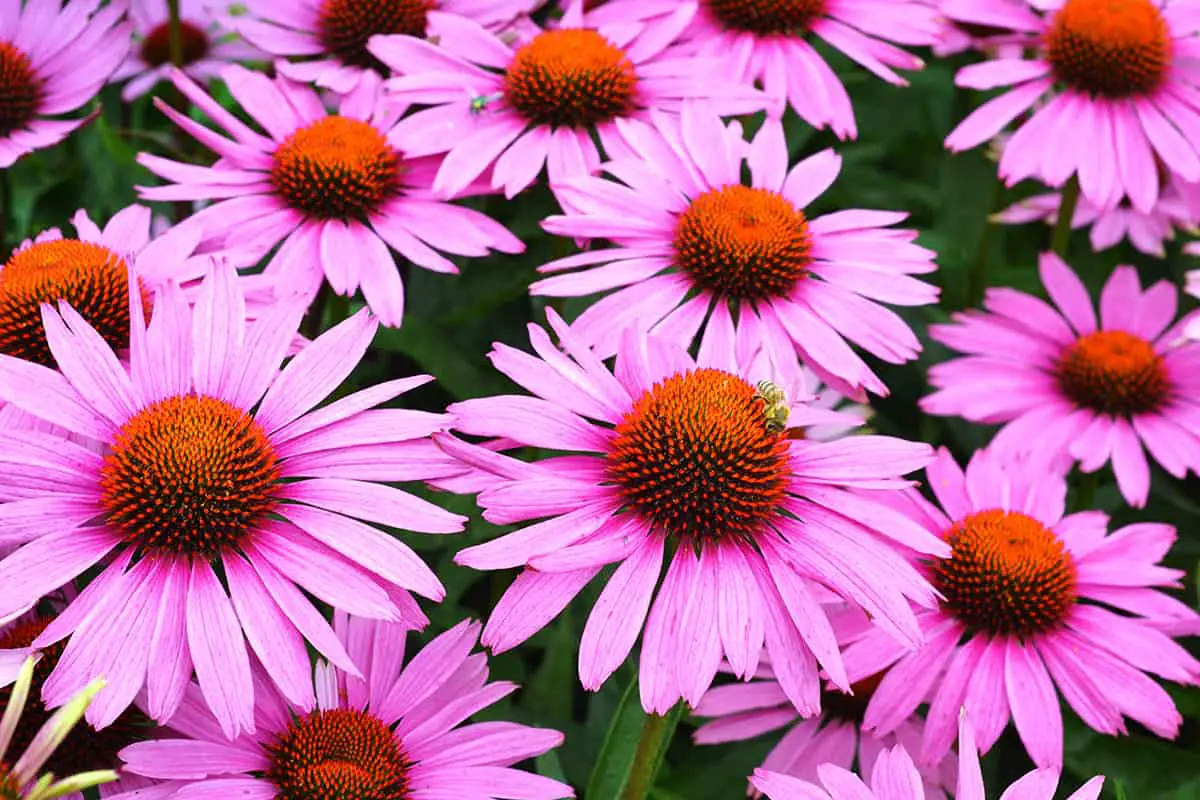
If you have dry, low-quality soil, Echinacea Purpurea can be a vibrant solution for your garden.
The plant typically reaches up to 4 feet in height. Its showy pinkish-purple flowers catch the eye from early summer to mid-fall. They come alive in various soil types, albeit they prefer a well-drained, moist loam.
You’ll find Echinacea Purpurea to be more than just eye-catching. It’s a true survivor, adaptable to tough conditions. These plants withstand drought and make the most out of poor-quality soil. They deliver a burst of color with little input from you.
Your garden benefits from Purple Coneflower beyond its beauty. It attracts pollinators such as bees and butterflies, enhancing the health of your entire garden. These rugged flowers are a symbol of strength and resilience, drawing in nature’s helpers with their lively blooms.
Rain Lily
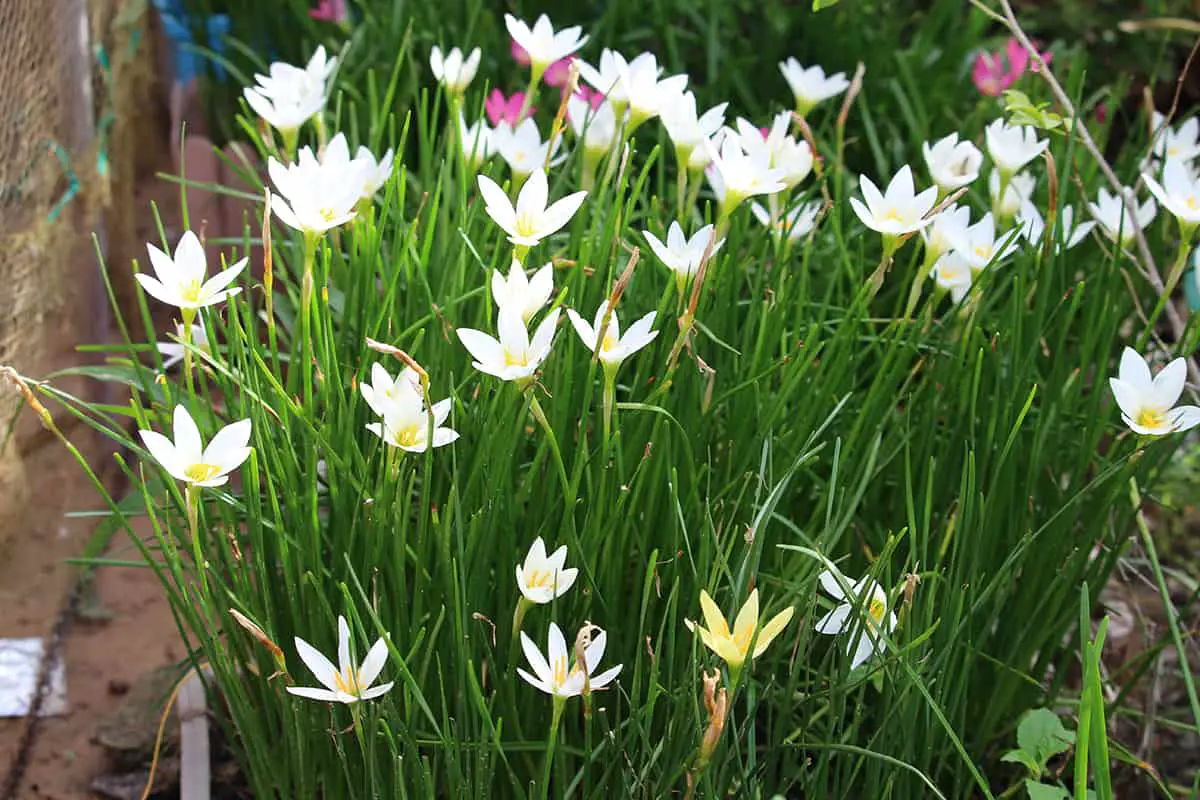
Rain lilies flowers spring up quickly after rainfall. In areas with less fertile ground, they still flourish. Your rainy season can turn into a display of delicate blooms.
The ideal conditions for these plants include exposure to full sun to partial shade, demonstrating their adaptability to varying levels of sunlight. They can tolerate a wide range of soil types, even those of poor quality, making them a versatile choice for different garden settings.
When planting, it’s recommended to plant the bulbs 2 inches deep and space them 6 to 12 inches apart to ensure proper growth. For continuous growth, selecting a spot that receives some rainfall will benefit the plants. Rain lilies are known for their resilience and can survive in conditions where other plants might not. If you reside in a region with mild winters, these plants can be grown outdoors throughout the year. In contrast, for those in colder climates, growing them in pots indoors during frost periods is a viable option.
Rain lilies need moderate watering, with an increase following dry spells to support their growth. Additionally, for established plants, fertilizing is not necessary, simplifying their care and maintenance.
Rose Of Sharon (Hibiscus Syriacus)
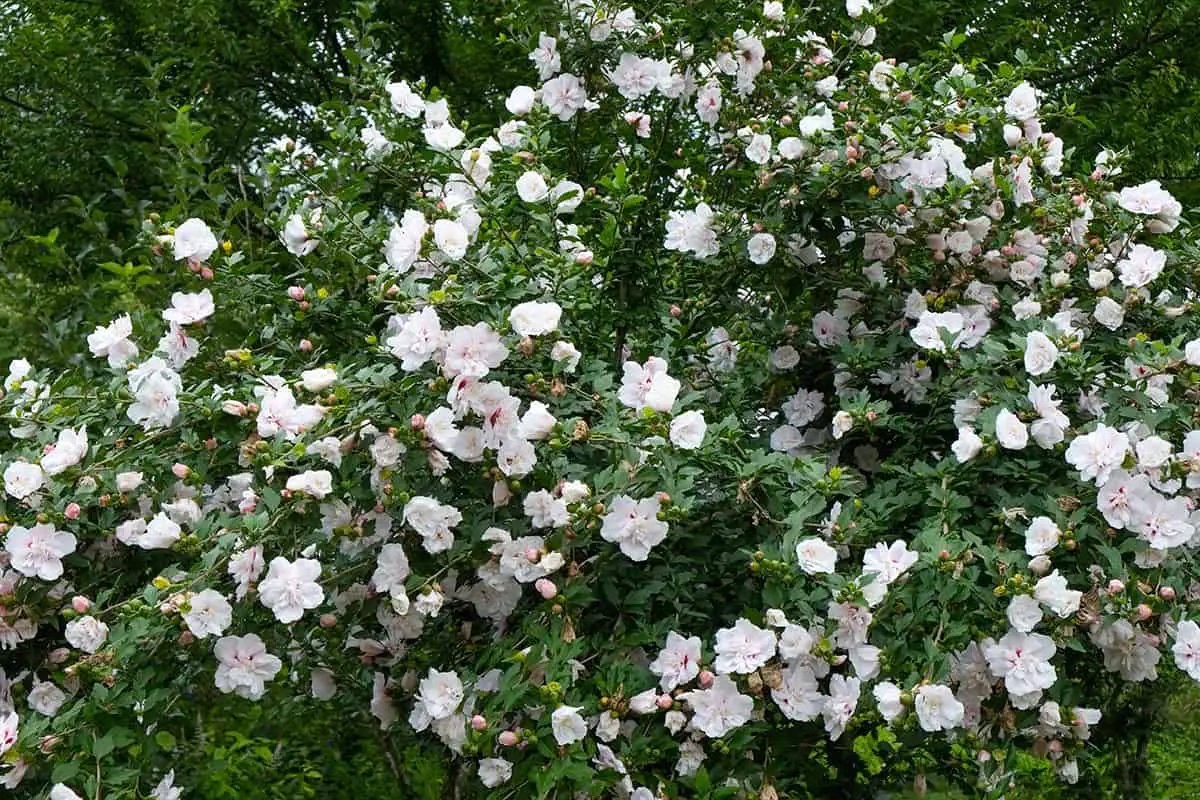
The Rose of Sharon is a resilient plant. It thrives even in poor soil. You’ll notice it blooms from summer to fall. The flowers come in several colors.
The Rose of Sharon plant flourishes when it receives full sunlight but can also tolerate partial shades. It doesn’t demand rich ground. Your garden’s tough spots are perfect for this hardy shrub. Remember, it can handle less-than-ideal conditions. It’s known for its wide tolerance to soil pH and drought.
For optimal care, it’s important to water the Rose of Sharon during periods of dry weather to ensure it stays hydrated. Fertilizing the plant lightly once a year will provide the necessary nutrients for its growth and flowering. Pruning should be done in late winter or early spring to help maintain its shape and promote vigorous growth.
In terms of growth habits, the Rose of Sharon can reach a height of 8 to 12 feet and has a spread of 6 to 10 feet wide. This allows it to make a significant visual impact in any garden, contributing both height and breadth to the landscape.
Shankapushpi
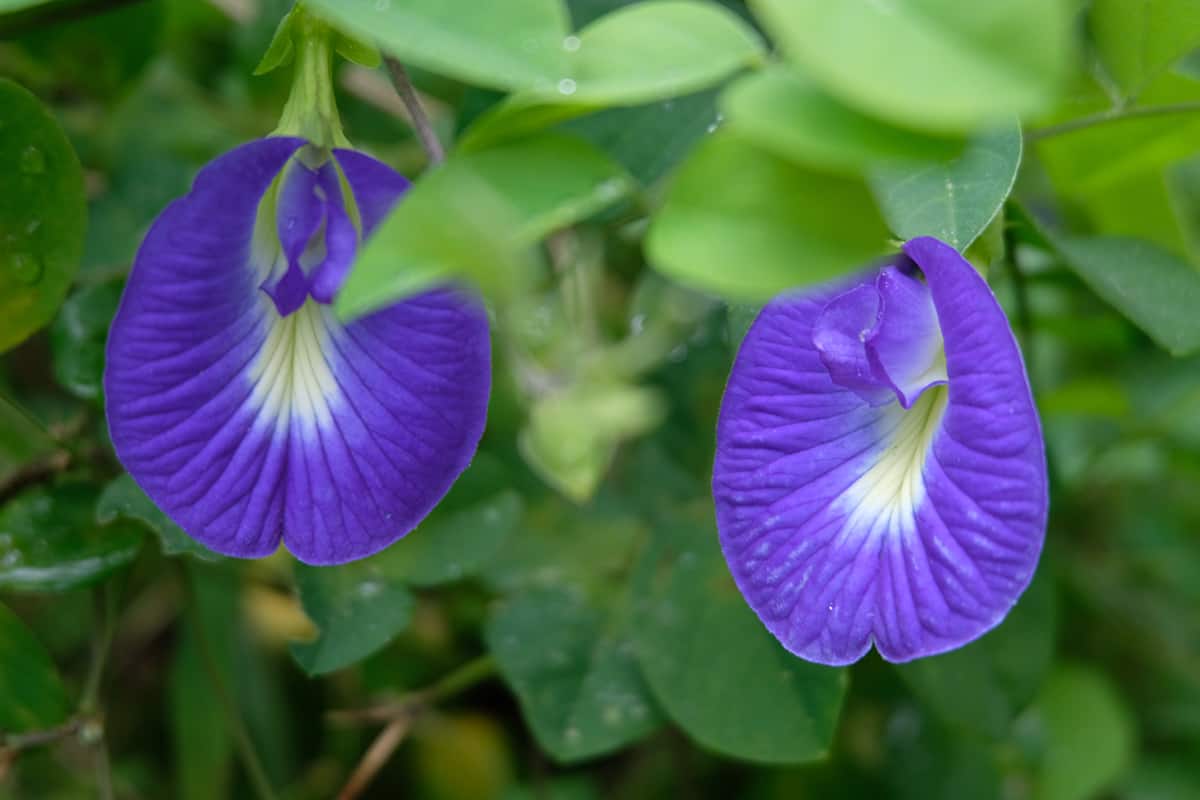
With its small, delicate flowers and vine-like growth, Shankapushpi might surprise you with its toughness. It prefers sunny locations but doesn’t demand rich, fertile ground. If you have soil that’s less than ideal, Shankapushpi can be a suitable choice. This plant can also withstand some drought and need moderate watering.
In addition to its durability, Shankapushpi, known botanically as Convolvulus pluricaulis has a history of use in Ayurveda.
Tickseed (Coreopsis)
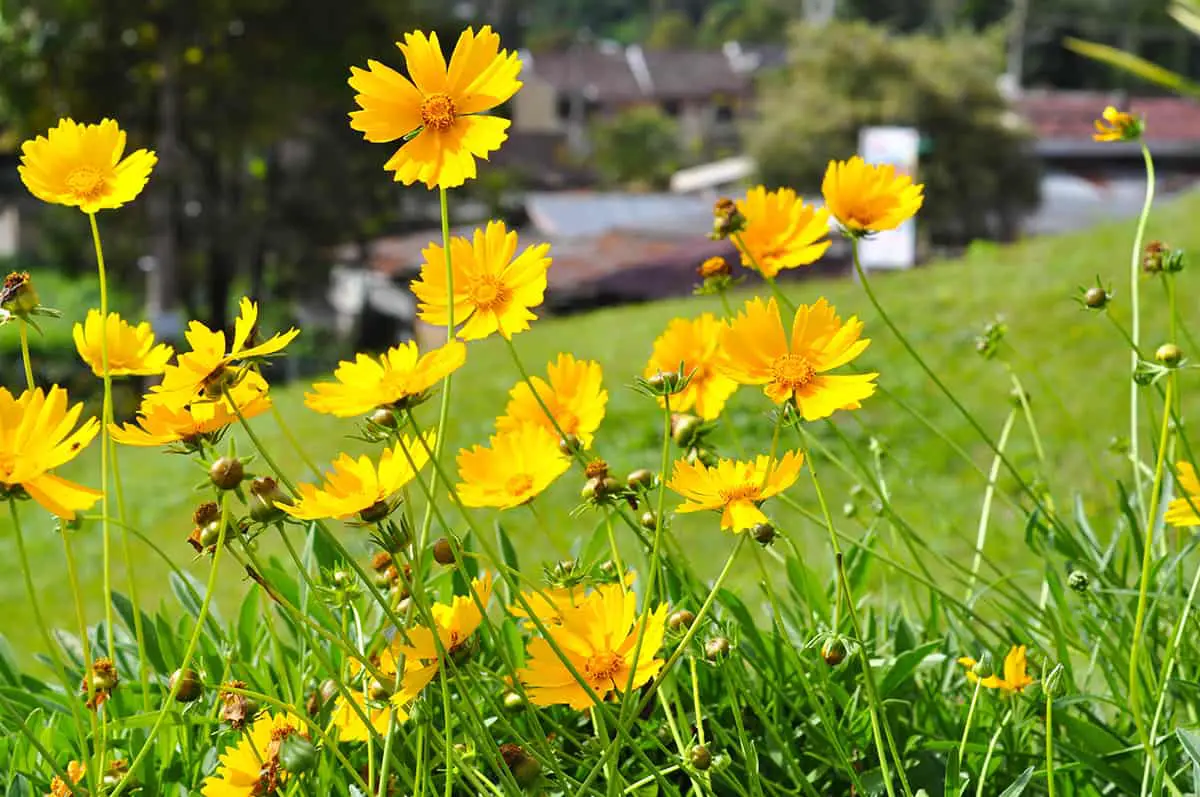
Tickseed, scientifically referred to as Coreopsis is at home in the daisy family, is known for its resilience. It thrives in sandy and rocky soils, and can withstand drought, heat, and humidity.
Coreopsis verticillata, also called Threadleaf Coreopsis, stands out with bushy clumps. It demands little care, growing 2-3 feet tall, matching its width. The plant favors infertile soil and needs full sun exposure.
Coreopsis pubescens adapts well to poor, rocky soils. Its variety, ‘Sunshine Superman’, will keep blooming if you remove faded flowers. Utilize it in gardens for color and texture.
Coreopsis lanceolata, another species, graces fields with vibrant yellow flowers. Its easy-going nature lets you plant it in dry to medium well-drained soil.
For optimal care, the plant requires only sparing amounts of water, highlighting its low-water needs. It thrives best in lean, well-drained soil, ensuring that excess moisture does not impede its growth. A preference for full sun means the plant should be situated in a spot where it can bask in ample sunlight throughout the day.
To prolong the blooming period, regular deadheading of spent flowers is recommended, as this encourages the plant to produce more blooms
Wedelia
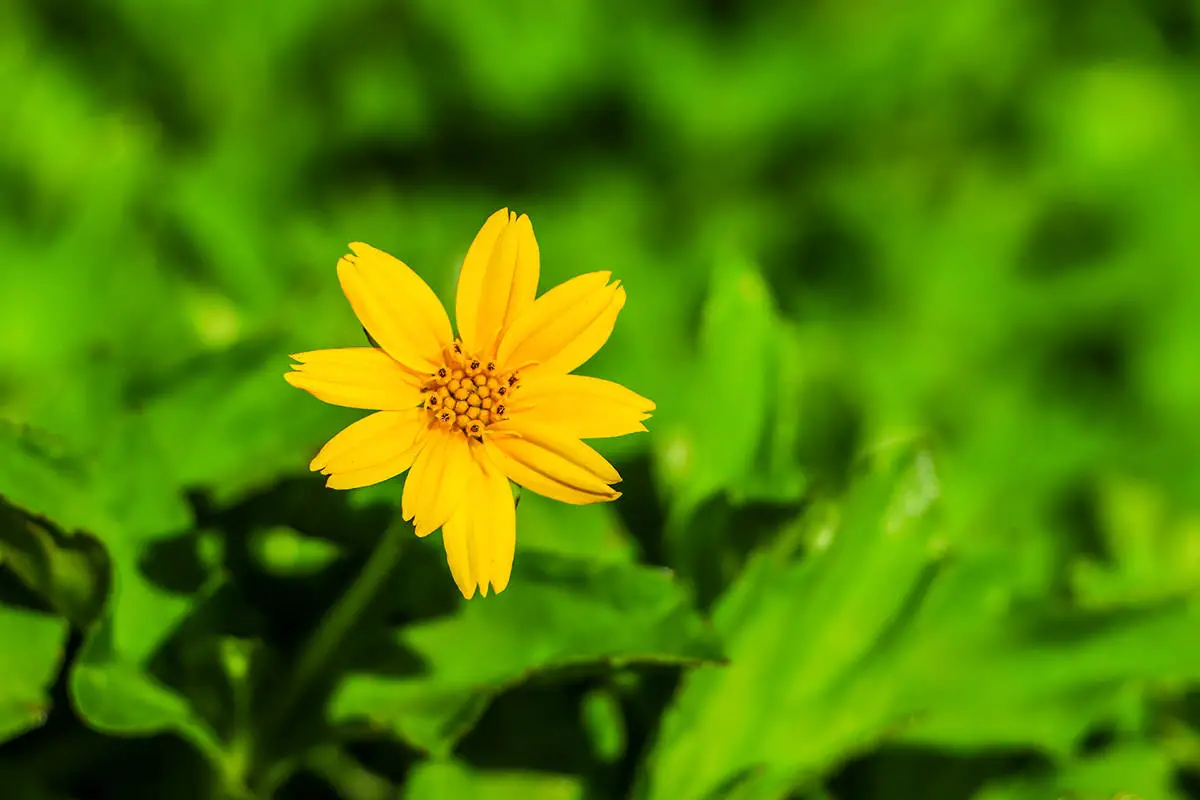
Wedelia can adapt to a variety of environments, often outperforming other species in less fertile areas. Its adaptability makes it a practical choice for challenging landscapes.
When growing Wedelia, it’s best to plant it in areas that receive plenty of sunlight to ensure optimal flower production. This plant is known for its robust growth even in less-than-ideal conditions and generally does not require additional fertilizers. As a drought-resistant species, Wedelia thrives with just occasional watering.
For those looking to achieve the best growing conditions, aim for a location that offers full sun to partial shade with a soil pH ranging from 5.5 to 7.5. To establish dense coverage, plants should be spaced approximately 18 inches apart.
A notable characteristic of Wedelia is its ability to spread quickly by rooting from stem nodes that come into contact with the ground, making it an effective ground cover that can help reduce soil erosion. Although it is a hardy plant, regular pruning is beneficial to maintain its shape and promote vigorous, healthy growth.
In terms of management, Wedelia prefers infrequent but deep watering sessions. It tolerates severe trimming, allowing gardeners to manage its spread and shape effectively. Additionally, this plant is adaptable to a wide variety of soil types, further showcasing its versatility and ease of care in a range of garden settings.
Remember, despite its benefits, some consider Wedelia invasive due to its aggressive spread. Monitor its growth to keep it contained within your desired area.
Wild Bee Balm (Monarda Fistulosa)
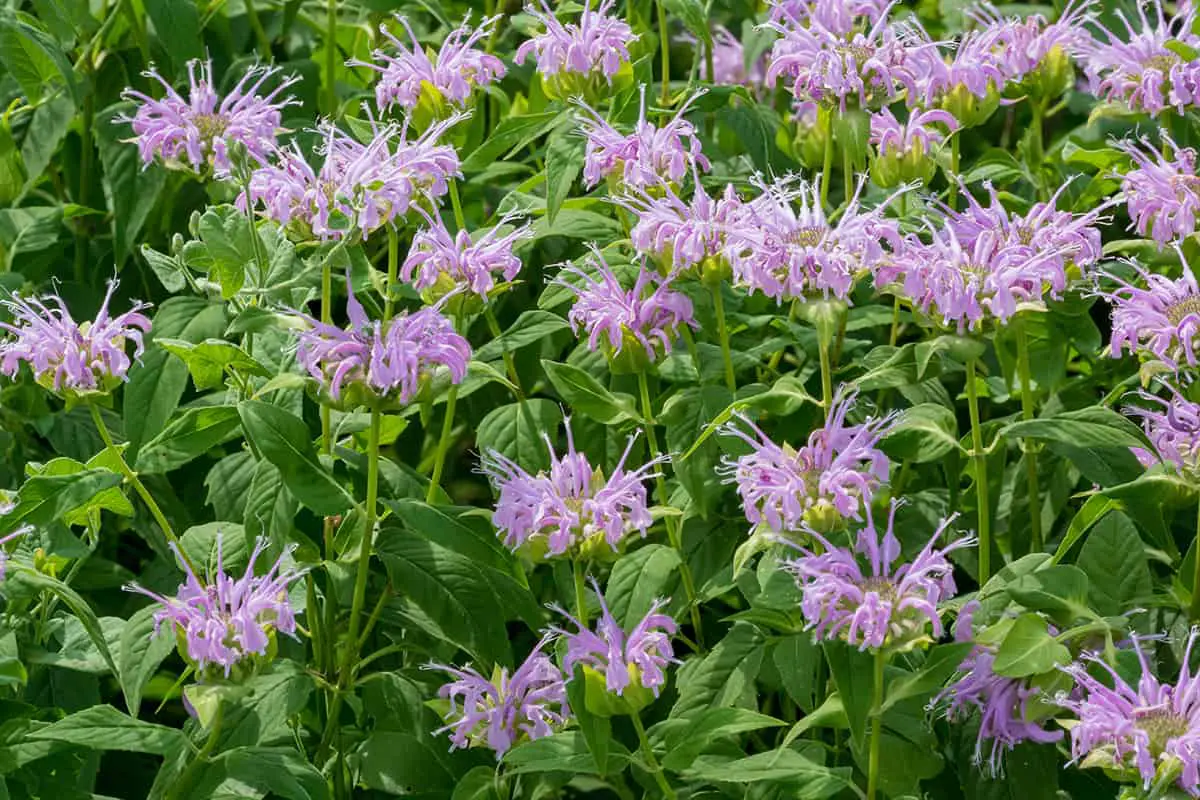
Monarda fistulosa, also recognized as wild bee balm, thrives in a range of soil conditions and is often found in prairies, at woodland edges, and in other less-cultivated landscapes.
This plant benefits from exposure to full sun to partial shade. Its water needs are moderate to low. Monarda fistulosa is notably drought-resistant, adding to its appeal for easy-care gardens. Once it has taken root in your garden, it requires minimal attention.
Wild bee balm typically reaches a height of 2 to 4 feet and blooms in the summer, showcasing lavender flowers that attract a variety of pollinators. Bees and butterflies, in particular, are frequent visitors, enhancing the ecological value of your garden. Beyond its aesthetic appeal, this plant is also valued for its uses in herbal remedies, offering benefits that extend beyond its beauty.
Yarrow (Achillea)
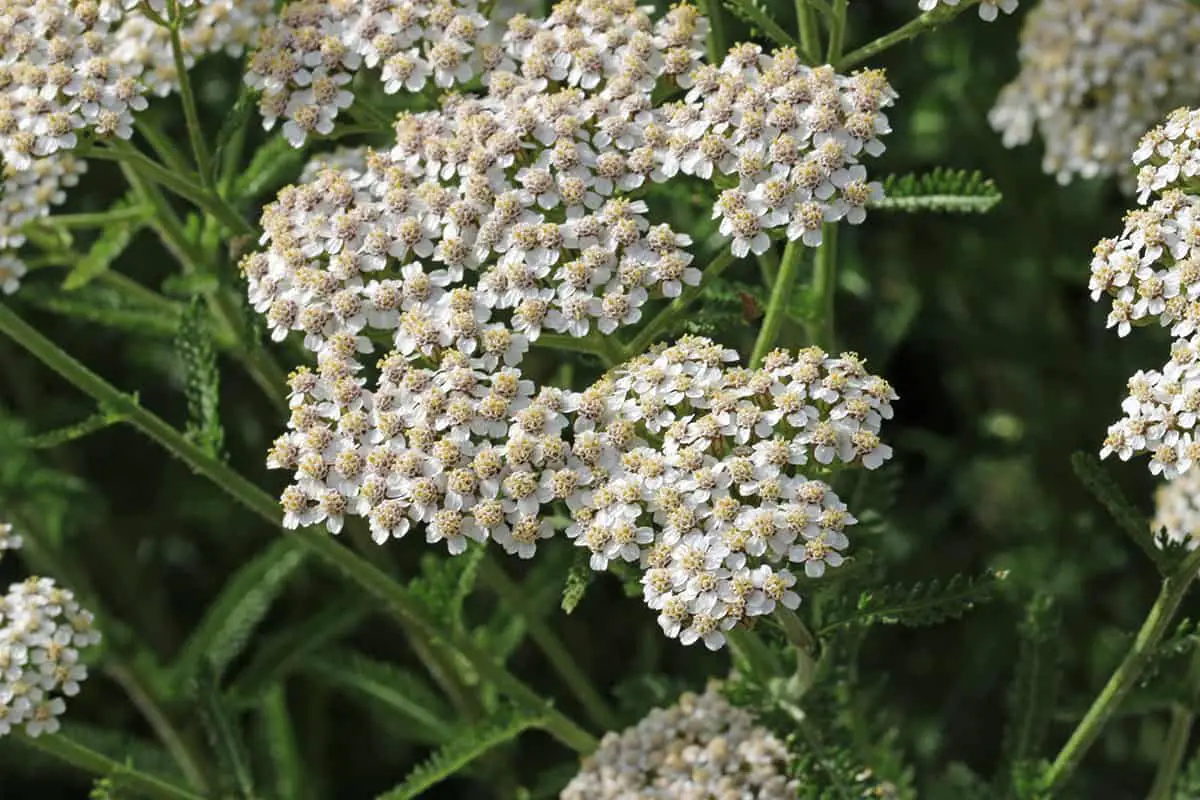
Yarrow, known scientifically as Achillea millefolium, stands out as a hardy perennial that is well-suited to thrive in poor soil conditions. This drought-tolerant plant is capable of enduring in less fertile environments, making it a robust addition to any garden.
In terms of sunlight, yarrow prefers full sun but can also grow in partial shade. It flourishes best in well-drained, poor soils.
The plant is characterized by its feathery foliage and distinctive dome-shaped clusters of flowers, which can be white, pink, or yellow. Yarrow typically reaches a height of 2 to 3 feet and blooms from late spring through fall, adding long-lasting color to the garden landscape.
Yarrow is commonly seen in gardens and along roadsides, valued for its ability to adapt to various soil types and conditions. This versatility makes it an excellent choice for gardeners looking to incorporate resilient and attractive plants into their outdoor spaces.
Beyond its aesthetic appeal, yarrow offers several benefits. It attracts beneficial insects, including pollinators, to the garden, supporting biodiversity. Historically, yarrow has been used for its medicinal properties, contributing to its value beyond landscaping. Additionally, its dense growth habit can aid in erosion control, helping to stabilize soil and prevent erosion in vulnerable areas.
For successful growth, choose a sunny spot and avoid overwatering. Yarrow can also withstand dry periods, ensuring blooms when other plants might suffer.
